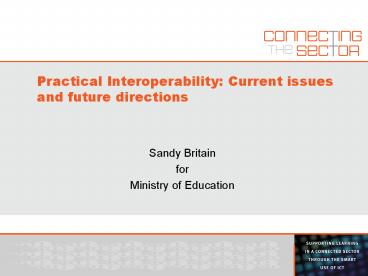Practical Interoperability: Current issues and future directions - PowerPoint PPT Presentation
1 / 33
Title:
Practical Interoperability: Current issues and future directions
Description:
Practical Interoperability: Current issues and future directions. Sandy Britain. for ... content in one application and then transport to run in another application ... – PowerPoint PPT presentation
Number of Views:57
Avg rating:3.0/5.0
Title: Practical Interoperability: Current issues and future directions
1
Practical Interoperability Current issues and
future directions
- Sandy Britain
- for
- Ministry of Education
2
A brief history of interoperability in
educational technology
- Traditionally administrative and academic
sub-systems have been loosely connected
Administration
Teaching and Learning
Enrolment
Certification
3
Electronic systems deployed in administrative area
Teaching and learning
Student Records System
Library System
Finance System
Research
4
Then came networks, the internet, e-learning and
e-research
LMS systems
SRS
Digital content
Library System
Collaborative Software
Finance System
5
Issue for institutions duplicating systems and
data
new LMS
All in one ? Content management ? Discover ? Cat
aloguing ? Course management ? Authentication ? Au
thorization ? Packaging
Now includes ? Content management ? Discover ?
Collaboration ? Course management ?
Authentication ? Authorization ? Packaging ?
Assessment
Complete solution ? Grading ? Audit ? Report ?
Course management ? Authentication ?
Authorization
6
Issues for institutions
- Incompatible data formats
- Proprietary systems
- Duplication of functionality
- Paying for multiple systems...
- ...and to maintain data in multiple locations
7
Possible Solutions
- Build key system functionality into a single
product - Create bespoke integrations between existing
systems - Get systems and data to work together (achieve
interoperability) by defining open standard
interface specifications - Disaggregate existing systems into lightweight
components with middleware layer
8
IMS
- Metadata
- Content Packaging
- QTI
- Accessibility
- Enterprise
- Learner Information Profiling(LIP)
- Learning Design
- Digital Repositories Framework
9
LMS systems
SRS
Enterprise
Content Packaging
Digital content
Library System
Metadata
Collaborative Software
Finance System
10
Quick summary
- Interoperability is highly desirable if not
essential - Standards are necessary
- Specifications are one way to approach creating
useful standards
11
So far so good. But what does this mean in
practice in an institutional context?
12
Content Interoperability
- Problem develop structured educational content
in one application and then transport to run in
another application - Solution IMS content packaging, SCORM
13
Enterprise Interoperability
- Problem Moving student and Course data from
student records system to LMS system - Applicable standards specification IMS
Enterprise - Issues Slow uptake of specs by vendors,
heavy-weight specification, perceived as simpler
and more cost-effective to create a lightweight
bespoke solution
14
Tools interoperability (Teacher)
- Problem The institutions LMS is a good tool
for structuring and managing my course but - For authoring content it is slow and inefficient
- I have other tools I want to use for creating
specific lessons but dont want to confuse
learners
15
Demonstration of tools interoperability
- Moodle is the LMS
- eXe is the Content Authoring System
- LAMS is a specialist activity sequence creation
and management system
16
(No Transcript)
17
(No Transcript)
18
(No Transcript)
19
(No Transcript)
20
(No Transcript)
21
(No Transcript)
22
(No Transcript)
23
(No Transcript)
24
(No Transcript)
25
(No Transcript)
26
(No Transcript)
27
(No Transcript)
28
(No Transcript)
29
(No Transcript)
30
(No Transcript)
31
(No Transcript)
32
The power of this demonstrator
- Can author sophisticated content outside of the
LMS - Can embed complex and active tools within a
course management environment - Provides flexibility for the course author and
coherence for the student
33
What does the demonstrator show
- From a teacher perspective there is great benefit
to being able to have interoperable tools - There arent standards to do this at present
- Helps point the way for standards development
- Indicates where there is duplication of
functionality in existing systems - So do we need a new approach to building learning
systems?































